NISSAN ARMADA 2006 1.G Repair Manual
Manufacturer: NISSAN, Model Year: 2006, Model line: ARMADA, Model: NISSAN ARMADA 2006 1.GPages: 352, PDF Size: 6.1 MB
Page 61 of 352
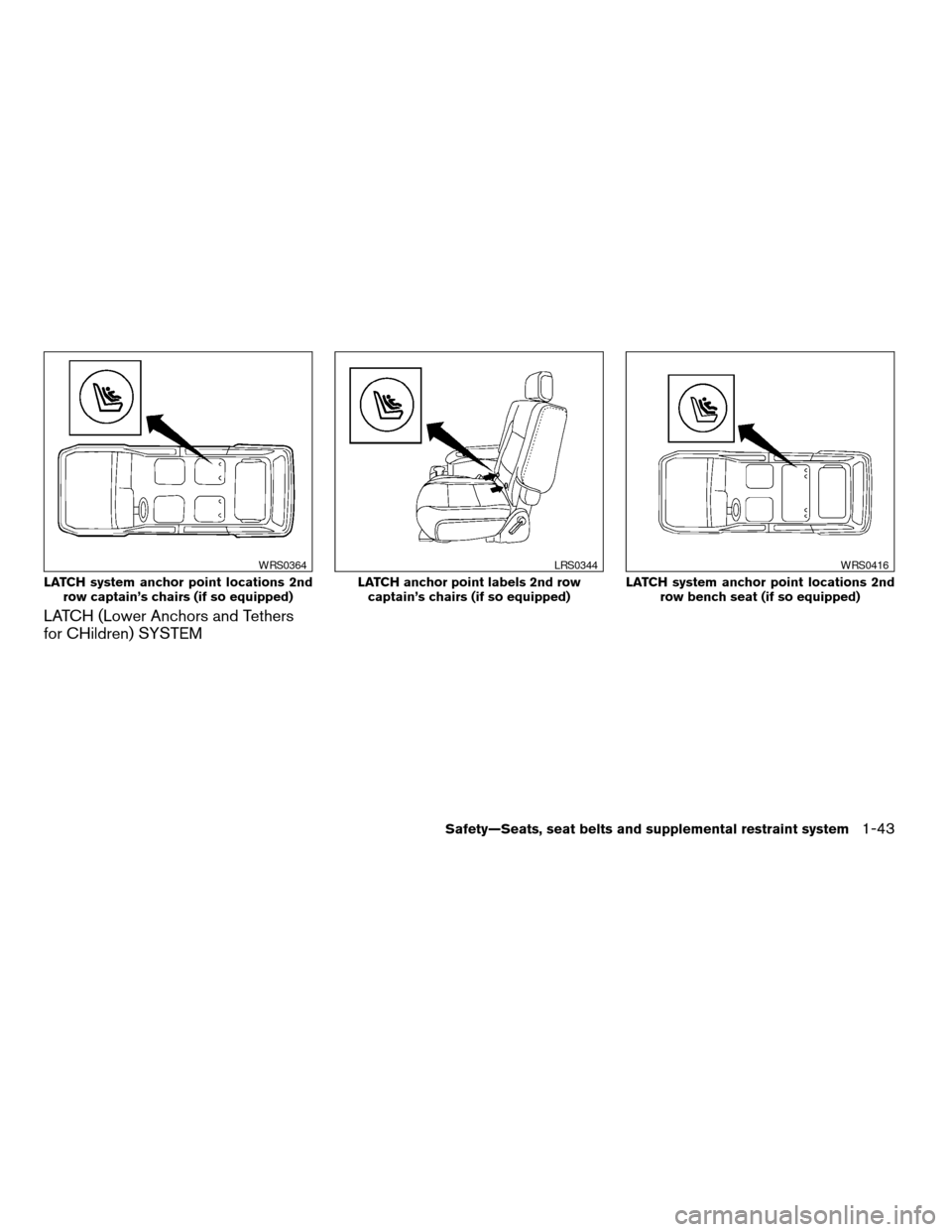
LATCH (Lower Anchors and Tethers
for CHildren) SYSTEM
LATCH system anchor point locations 2nd
row captain’s chairs (if so equipped)
WRS0364
LATCH anchor point labels 2nd row
captain’s chairs (if so equipped)
LRS0344
LATCH system anchor point locations 2nd
row bench seat (if so equipped)
WRS0416
Safety—Seats, seat belts and supplemental restraint system1-43
ZREVIEW COPYÐ2006 Armada(wzw)
Owners ManualÐUSA_English(nna)
06/15/05Ðdebbie
X
Page 62 of 352

The LATCH (Lower Anchors and Tethers for
CHildren) anchor points are located as follows:
c2nd row captain’s chairs (if so equipped): in
the seat cushions of both captain’s chairs.
c2nd row bench seat (if so equipped): in the
seat cushions of the 2nd row bench seat
outboard seating positions only. Do not at-
tempt to install a child restraint in the center
position using the LATCH anchors.
WARNING
cAttach LATCH system compatible child
restraints only at the locations shown. If
a child restraint is not secured properly,
your child could be seriously injured or
killed in an accident.
cThe LATCH system anchors are de-
signed to withstand only those loads
imposed by correctly fitted child re-
straints. Under no circumstance are
they to be used for adult seat belts or
harnesses.
Some child restraints include two rigid or
webbing-mounted attachments that can be con-
nected to two anchors located at certain seating
positions in your vehicle. This system is known as
the LATCH system. This system may also be
referred to as the ISOFIX or ISOFIX compatible
system. With this system, you do not have to use
a vehicle seat belt to secure the child restraint.
Your vehicle is equipped with special anchor
points that are used with LATCH system compat-
ible child restraints. Check your child restraint for
a label stating that it is compatible with the
LATCH system. This information may also be in
the child restraint owner’s manual. If you have
such a child restraint, refer to the illustration forthe seating positions equipped with LATCH sys-
tem anchors which can be used to secure the
child restraint.
The LATCH system anchors are located at the
rear of the seat cushion near the seatback. A
label is attached to the seatback to help you
locate the LATCH system anchors.
LATCH child restraints generally require the use
of a top tether strap. See “Top tether strap child
restraint” later in this section for installation in-
structions.
When installing a child restraint, carefully read
and follow the instructions in this manual and
those supplied with the child restraint.
When you install a LATCH system compatible
child restraint to the lower anchor attachments,
follow these steps:
WARNING
Inspect the lower anchors by inserting
your fingers into the lower anchor area
and feeling to make sure there are no
obstructions over the LATCH system an-
chors, such as seat belt webbing or seat
cushion material. The child restraint will
not be secured properly if the LATCH sys-
tem anchors are obstructed.
LATCH anchor point labels 2nd row bench
seat (if so equipped)
LRS0382
1-44Safety—Seats, seat belts and supplemental restraint system
ZREVIEW COPYÐ2006 Armada(wzw)
Owners ManualÐUSA_English(nna)
06/15/05Ðdebbie
X
Page 63 of 352
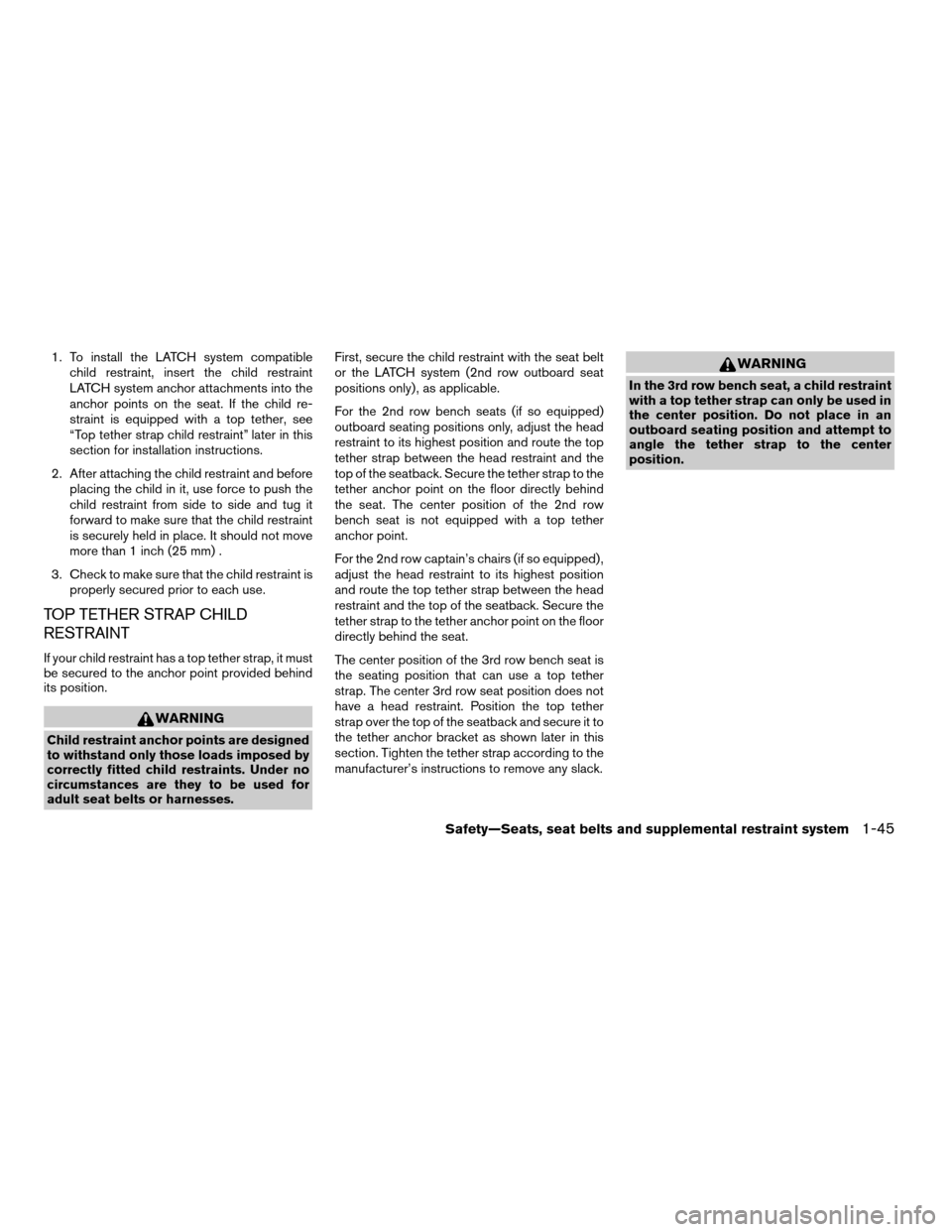
1. To install the LATCH system compatible
child restraint, insert the child restraint
LATCH system anchor attachments into the
anchor points on the seat. If the child re-
straint is equipped with a top tether, see
“Top tether strap child restraint” later in this
section for installation instructions.
2. After attaching the child restraint and before
placing the child in it, use force to push the
child restraint from side to side and tug it
forward to make sure that the child restraint
is securely held in place. It should not move
more than 1 inch (25 mm) .
3. Check to make sure that the child restraint is
properly secured prior to each use.
TOP TETHER STRAP CHILD
RESTRAINT
If your child restraint has a top tether strap, it must
be secured to the anchor point provided behind
its position.
WARNING
Child restraint anchor points are designed
to withstand only those loads imposed by
correctly fitted child restraints. Under no
circumstances are they to be used for
adult seat belts or harnesses.First, secure the child restraint with the seat belt
or the LATCH system (2nd row outboard seat
positions only) , as applicable.
For the 2nd row bench seats (if so equipped)
outboard seating positions only, adjust the head
restraint to its highest position and route the top
tether strap between the head restraint and the
top of the seatback. Secure the tether strap to the
tether anchor point on the floor directly behind
the seat. The center position of the 2nd row
bench seat is not equipped with a top tether
anchor point.
For the 2nd row captain’s chairs (if so equipped) ,
adjust the head restraint to its highest position
and route the top tether strap between the head
restraint and the top of the seatback. Secure the
tether strap to the tether anchor point on the floor
directly behind the seat.
The center position of the 3rd row bench seat is
the seating position that can use a top tether
strap. The center 3rd row seat position does not
have a head restraint. Position the top tether
strap over the top of the seatback and secure it to
the tether anchor bracket as shown later in this
section. Tighten the tether strap according to the
manufacturer’s instructions to remove any slack.
WARNING
In the 3rd row bench seat, a child restraint
with a top tether strap can only be used in
the center position. Do not place in an
outboard seating position and attempt to
angle the tether strap to the center
position.
Safety—Seats, seat belts and supplemental restraint system1-45
ZREVIEW COPYÐ2006 Armada(wzw)
Owners ManualÐUSA_English(nna)
06/15/05Ðdebbie
X
Page 64 of 352
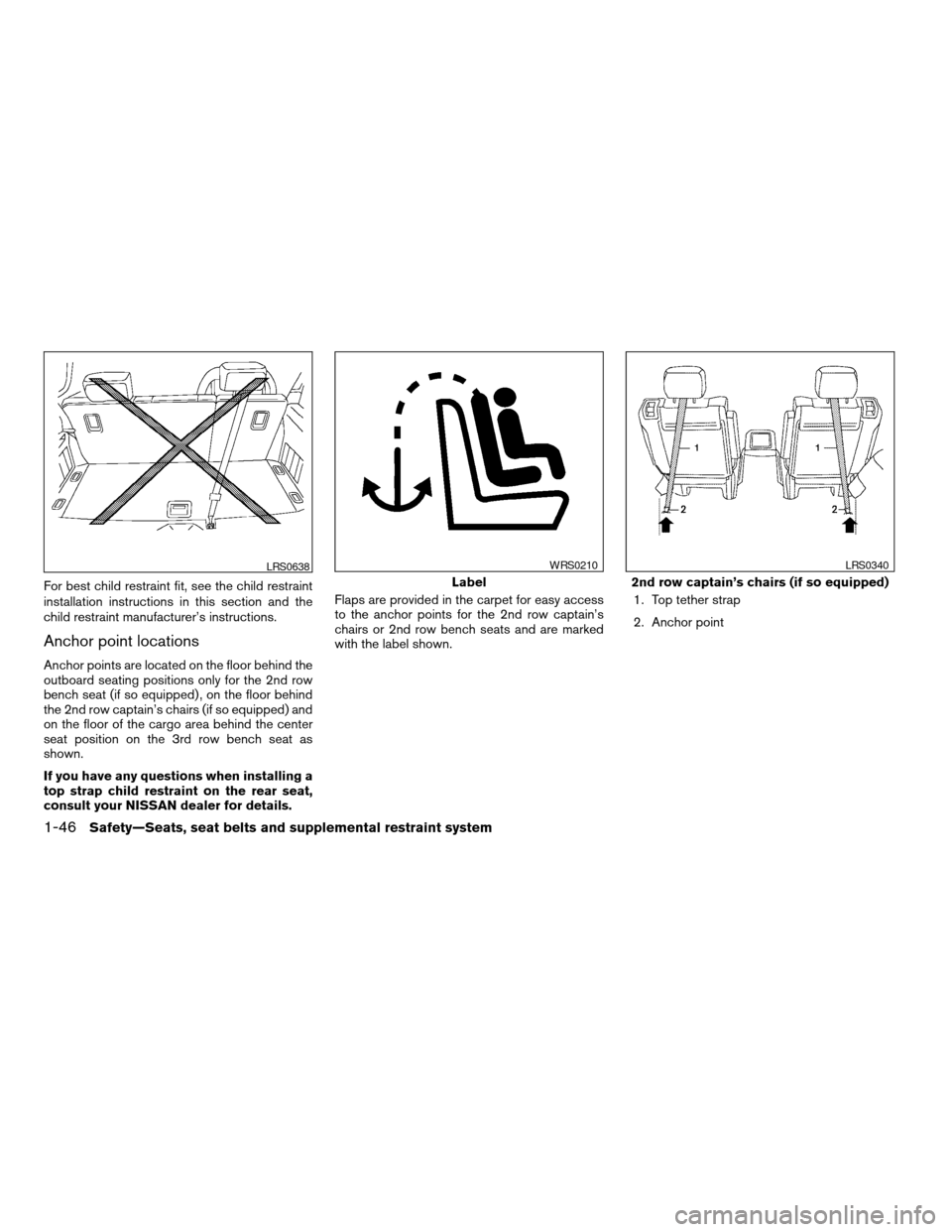
For best child restraint fit, see the child restraint
installation instructions in this section and the
child restraint manufacturer’s instructions.
Anchor point locations
Anchor points are located on the floor behind the
outboard seating positions only for the 2nd row
bench seat (if so equipped) , on the floor behind
the 2nd row captain’s chairs (if so equipped) and
on the floor of the cargo area behind the center
seat position on the 3rd row bench seat as
shown.
If you have any questions when installing a
top strap child restraint on the rear seat,
consult your NISSAN dealer for details.Flaps are provided in the carpet for easy access
to the anchor points for the 2nd row captain’s
chairs or 2nd row bench seats and are marked
with the label shown.1. Top tether strap
2. Anchor point
LRS0638
Label
WRS0210
2nd row captain’s chairs (if so equipped)
LRS0340
1-46Safety—Seats, seat belts and supplemental restraint system
ZREVIEW COPYÐ2006 Armada(wzw)
Owners ManualÐUSA_English(nna)
06/15/05Ðdebbie
X
Page 65 of 352
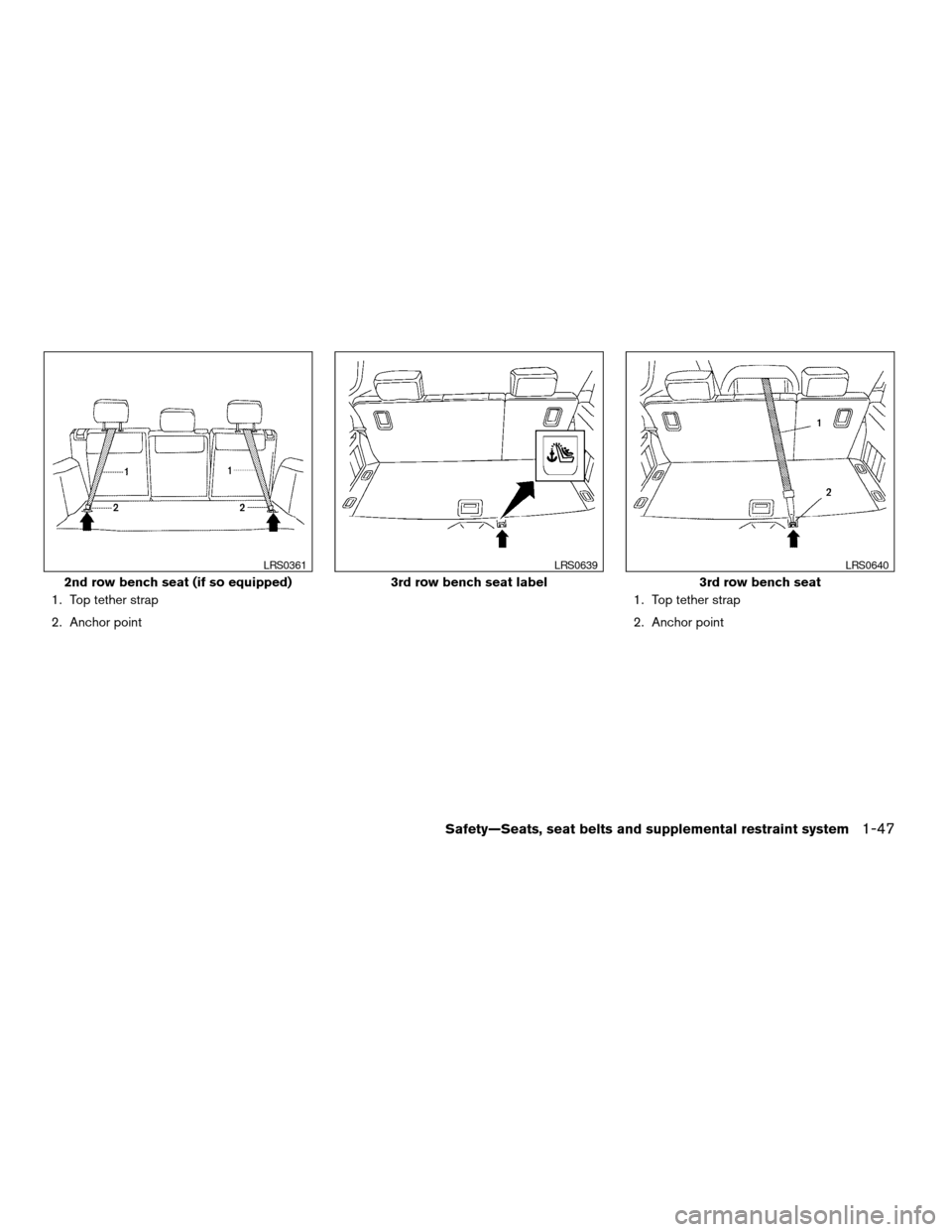
1. Top tether strap
2. Anchor point1. Top tether strap
2. Anchor point
2nd row bench seat (if so equipped)
LRS0361
3rd row bench seat label
LRS0639
3rd row bench seat
LRS0640
Safety—Seats, seat belts and supplemental restraint system1-47
ZREVIEW COPYÐ2006 Armada(wzw)
Owners ManualÐUSA_English(nna)
06/15/05Ðdebbie
X
Page 66 of 352
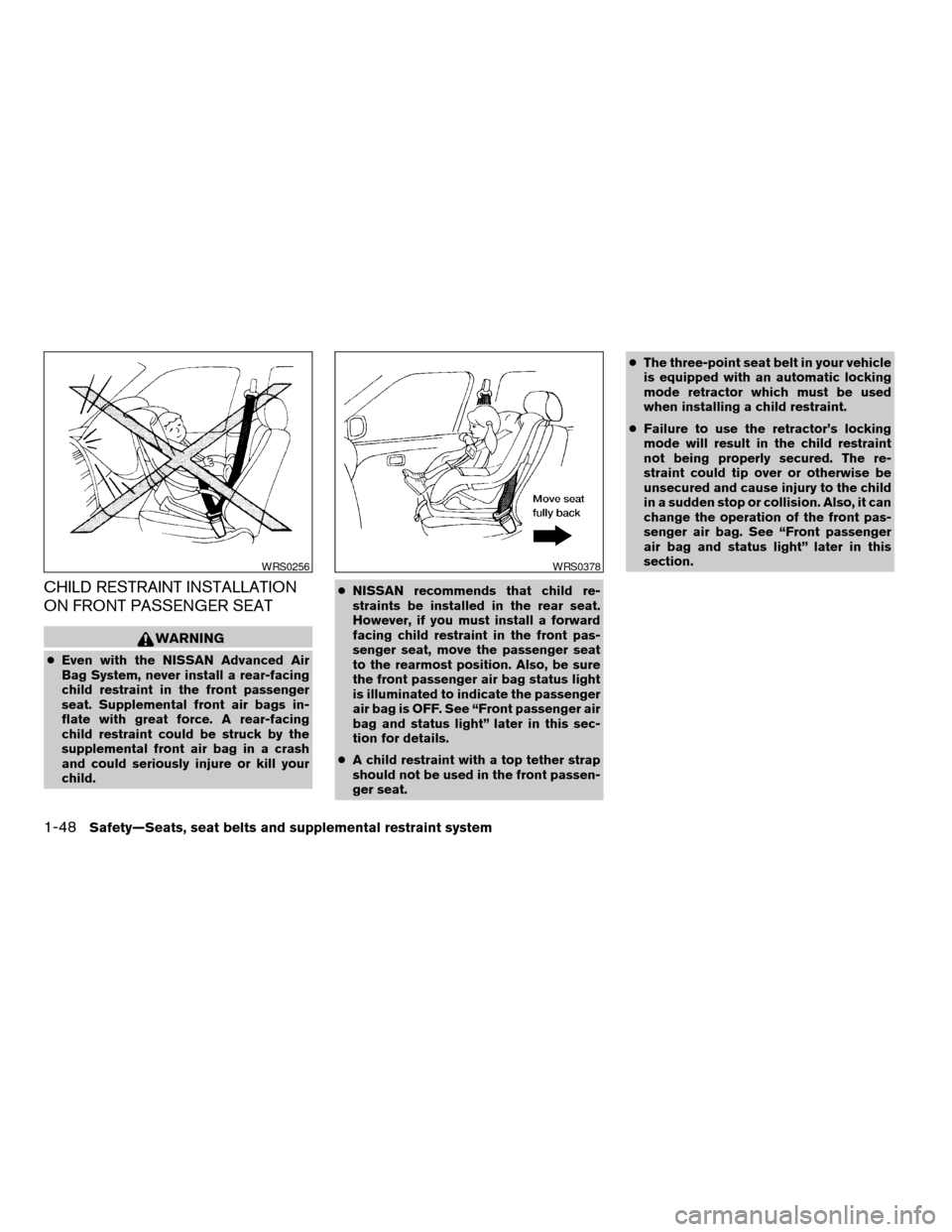
CHILD RESTRAINT INSTALLATION
ON FRONT PASSENGER SEAT
WARNING
cEven with the NISSAN Advanced Air
Bag System, never install a rear-facing
child restraint in the front passenger
seat. Supplemental front air bags in-
flate with great force. A rear-facing
child restraint could be struck by the
supplemental front air bag in a crash
and could seriously injure or kill your
child.cNISSAN recommends that child re-
straints be installed in the rear seat.
However, if you must install a forward
facing child restraint in the front pas-
senger seat, move the passenger seat
to the rearmost position. Also, be sure
the front passenger air bag status light
is illuminated to indicate the passenger
air bag is OFF. See “Front passenger air
bag and status light” later in this sec-
tion for details.
cA child restraint with a top tether strap
should not be used in the front passen-
ger seat.cThe three-point seat belt in your vehicle
is equipped with an automatic locking
mode retractor which must be used
when installing a child restraint.
cFailure to use the retractor’s locking
mode will result in the child restraint
not being properly secured. The re-
straint could tip over or otherwise be
unsecured and cause injury to the child
in a sudden stop or collision. Also, it can
change the operation of the front pas-
senger air bag. See “Front passenger
air bag and status light” later in this
section.
WRS0256WRS0378
1-48Safety—Seats, seat belts and supplemental restraint system
ZREVIEW COPYÐ2006 Armada(wzw)
Owners ManualÐUSA_English(nna)
06/15/05Ðdebbie
X
Page 67 of 352

If you must install a child restraint in the front seat,
follow these steps:
s1Position the child restraint on the front pas-
senger seat.It should be placed in a
front-facing direction only. Move the
seat to the rearmost position.Adjust the
head restraint to its highest position. Always
follow the child restraint manufacturer’s in-
structions.Child restraints for infants
must be used in the rear-facing direc-
tion and therefore must not be used in
the front seat.The back of the child restraint should be
secured against the vehicle seat back. If
necessary, adjust or remove the head re-
straint to obtain the correct child restraint fit.
See “Head restraint adjustment” earlier in
this section. If the head restraint is removed,
store it in a secure place. Be sure to install
the head restraint when the child restraint is
removed. If the seating position does not
have an adjustable head restraint and it is
interfering with the proper child restraint fit,
try another seating position or a different
child restraint.
s2Route the seat belt tongue through the child
restraint and insert it into the buckle until you
hear and feel the latch engage.
Be sure to follow the child restraint manu-
facturer’s instructions for belt routing.
Front Facing — step 1WRS0379
Front Facing — step 2
WRS0159
Safety—Seats, seat belts and supplemental restraint system1-49
ZREVIEW COPYÐ2006 Armada(wzw)
Owners ManualÐUSA_English(nna)
06/15/05Ðdebbie
X
Page 68 of 352

s3Pull on the shoulder belt until all of the belt is
fully extended. At this time, the seat belt
retractor is in the automatic locking mode
(child restraint mode) . It reverts to emer-
gency locking mode when the seat belt is
fully retracted.s4Allow the seat belt to retract slightly. Pull up
on the shoulder belt to remove any slack in
the belt.s5Before placing the child in the child restraint,
use force to push the child restraint from
side to side, and tug it forward to make sure
that it is securely held in place. It should not
move more than 1 inch (25 mm) . If it does
move more than 1 inch (25 mm) , pull again
on the shoulder belt to further tighten the
child restraint. If unable to properly secure
the restraint move the restraint to another
seating position and try again , or try a differ-
ent child restraint. Not all child restraints fit in
all types of vehicles.
Front Facing — step 3
WRS0160
Front Facing — step 4
LRS0457
Front Facing — step 5
WRS0380
1-50Safety—Seats, seat belts and supplemental restraint system
ZREVIEW COPYÐ2006 Armada(wzw)
Owners ManualÐUSA_English(nna)
06/15/05Ðdebbie
X
Page 69 of 352
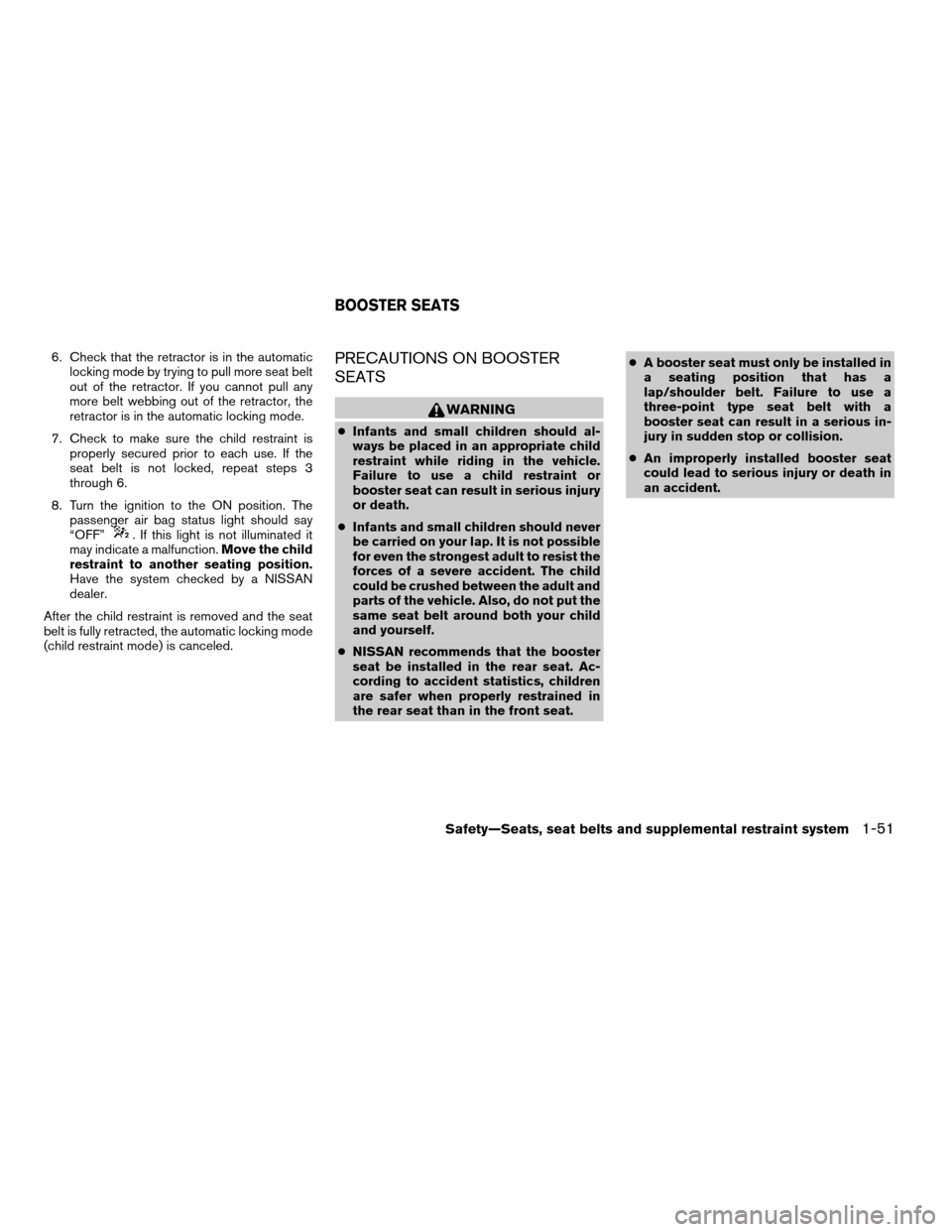
6. Check that the retractor is in the automatic
locking mode by trying to pull more seat belt
out of the retractor. If you cannot pull any
more belt webbing out of the retractor, the
retractor is in the automatic locking mode.
7. Check to make sure the child restraint is
properly secured prior to each use. If the
seat belt is not locked, repeat steps 3
through 6.
8. Turn the ignition to the ON position. The
passenger air bag status light should say
“OFF”
. If this light is not illuminated it
may indicate a malfunction.Move the child
restraint to another seating position.
Have the system checked by a NISSAN
dealer.
After the child restraint is removed and the seat
belt is fully retracted, the automatic locking mode
(child restraint mode) is canceled.
PRECAUTIONS ON BOOSTER
SEATS
WARNING
cInfants and small children should al-
ways be placed in an appropriate child
restraint while riding in the vehicle.
Failure to use a child restraint or
booster seat can result in serious injury
or death.
cInfants and small children should never
be carried on your lap. It is not possible
for even the strongest adult to resist the
forces of a severe accident. The child
could be crushed between the adult and
parts of the vehicle. Also, do not put the
same seat belt around both your child
and yourself.
cNISSAN recommends that the booster
seat be installed in the rear seat. Ac-
cording to accident statistics, children
are safer when properly restrained in
the rear seat than in the front seat.cA booster seat must only be installed in
a seating position that has a
lap/shoulder belt. Failure to use a
three-point type seat belt with a
booster seat can result in a serious in-
jury in sudden stop or collision.
cAn improperly installed booster seat
could lead to serious injury or death in
an accident.
BOOSTER SEATS
Safety—Seats, seat belts and supplemental restraint system1-51
ZREVIEW COPYÐ2006 Armada(wzw)
Owners ManualÐUSA_English(nna)
07/05/05Ðrhinson
X
Page 70 of 352
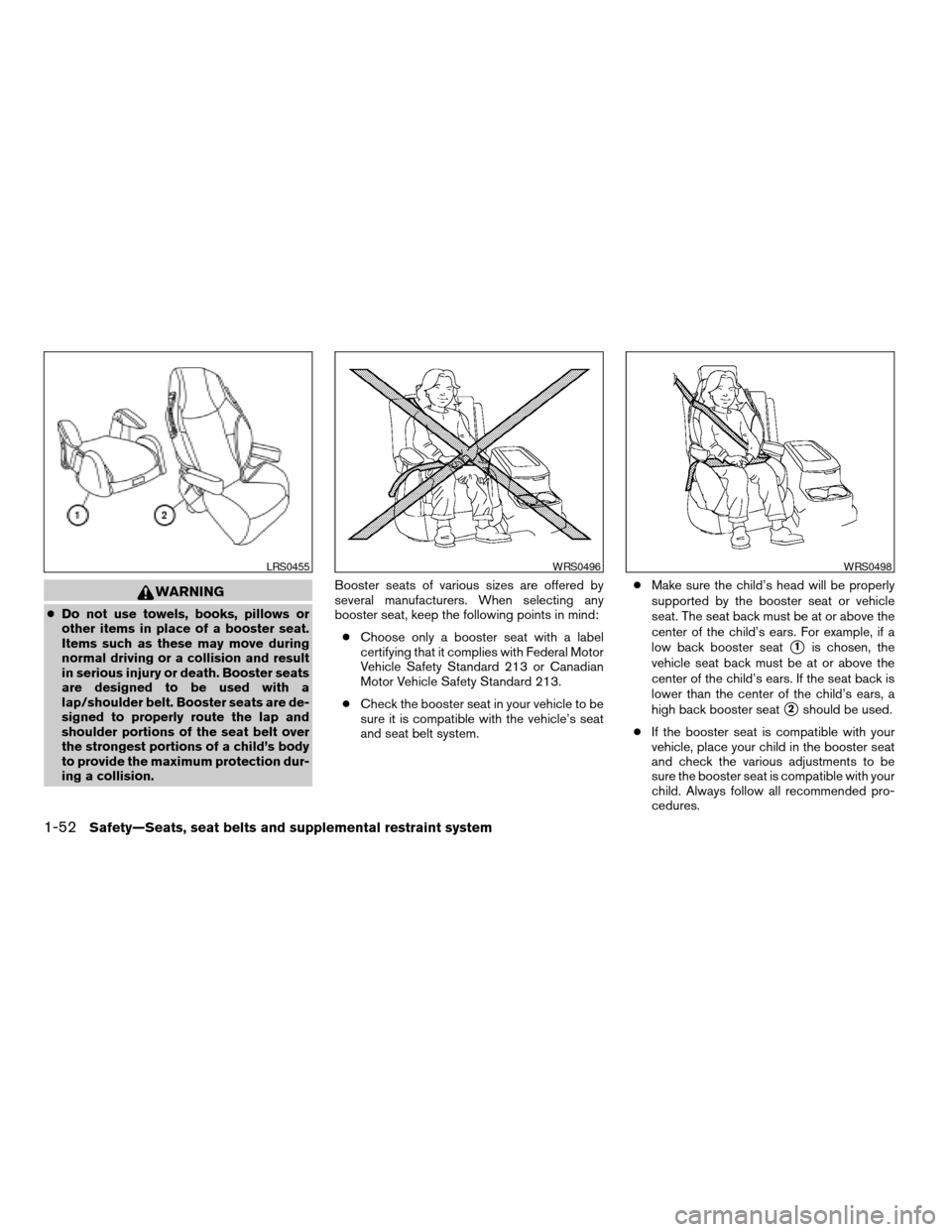
WARNING
cDo not use towels, books, pillows or
other items in place of a booster seat.
Items such as these may move during
normal driving or a collision and result
in serious injury or death. Booster seats
are designed to be used with a
lap/shoulder belt. Booster seats are de-
signed to properly route the lap and
shoulder portions of the seat belt over
the strongest portions of a child’s body
to provide the maximum protection dur-
ing a collision.Booster seats of various sizes are offered by
several manufacturers. When selecting any
booster seat, keep the following points in mind:
cChoose only a booster seat with a label
certifying that it complies with Federal Motor
Vehicle Safety Standard 213 or Canadian
Motor Vehicle Safety Standard 213.
cCheck the booster seat in your vehicle to be
sure it is compatible with the vehicle’s seat
and seat belt system.cMake sure the child’s head will be properly
supported by the booster seat or vehicle
seat. The seat back must be at or above the
center of the child’s ears. For example, if a
low back booster seat
s1is chosen, the
vehicle seat back must be at or above the
center of the child’s ears. If the seat back is
lower than the center of the child’s ears, a
high back booster seat
s2should be used.
cIf the booster seat is compatible with your
vehicle, place your child in the booster seat
and check the various adjustments to be
sure the booster seat is compatible with your
child. Always follow all recommended pro-
cedures.
LRS0455WRS0496WRS0498
1-52Safety—Seats, seat belts and supplemental restraint system
ZREVIEW COPYÐ2006 Armada(wzw)
Owners ManualÐUSA_English(nna)
06/15/05Ðdebbie
X